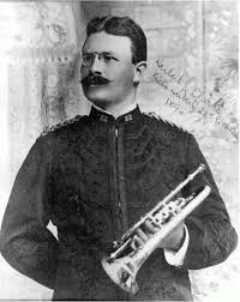The World Association of Symphonic Bands and Wind Ensembles as Told by William Johnson
Preface:
The purpose of this article is to give the reader some background about how the World Association for Symphonic Bands and Ensembles (WASBE) began, and to describe two international conferences for which I served as president, plus one international conference for which I served as conference chairman. I will conclude the article with how WASBE has changed the world of wind bands and what, in my judgement, will be the future of WASBE.
My involvement with the association began in 1978 with a phone call to my friend and colleague, Frank Battisti, Director of Wind Studies at the New England Conservatory in Boston. Frank was the president of the College Band Directors National Association (CBDNA) and had announced to the membership that CBDNA would organize and sponsor the first-ever international conference of wind band conductors, composers, publishers, instrument makers and performers to be held in England in July 1981. The purpose of my call to Frank was to let him know that I would be in Europe during the first half of 1979 on sabbatical leave to study British brass bands and would be happy to contact anyone on his behalf. He gave me a list of several people to contact and asked me to seek a venue where the conference could be held.
After speaking to many wind band people in the UK, as well as numerous people on the European continent, I finally discovered the Royal Northern College of Music (RNCM) in Manchester, England and the head of Wind Studies, Timothy Reynish. Tim was very excited about the possibility of organizing the first-ever international conference at the RNCM. I then contacted Frank and asked him to travel to Manchester as soon as possible. When Frank and Tim met two days later, the world of wind bands changed. I was asked to serve as the Executive Director for the conference that was scheduled for 7 days in July 1981.
Over 300 delegates from Europe, Africa, North America and Asia attended the conference. Twelve wind ensembles from Japan, Norway, Switzerland, United States, UK, Austria and Sweden were invited to perform in the RNCM Concert Hall, including a British brass band. With unusual foresight, Paul Yoder, Frederick Fennell, Frank Battisti, Tim Reynish and others envisioned a world organization of band and wind ensemble directors that would share ideas and discuss common problems and opportunities. There was much enthusiasm by those who attended that first gathering. For seven days participants from Europe, Africa, North America and Asia experienced daily concerts, seminars, discussions, and fellowship. At the end of the week, a board of directors was elected and WASBE was formed. The first official biennial international conference was planned for July 1983 in Skien, Norway. Treavor Ford of Norway would serve as the first president.
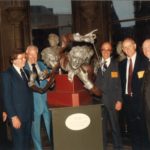
This photo was taken in the City Hall of Manchester, England in July, 1981. The people gathered around the statue of Sir John Barbirolli are left to right: J.W. Julian, Donald Hunsberger, Clare Grundman, William Johnson, and Frank Battisti. The person on the far right is unknown.
Since then, WASBE has held both regional and international conferences:
o Manchester, England, 1981
o Skien, Norway, 1983
o Kortrijk, Belgium, 1985
o Boston, USA, 1987
o Kerkrade, The Netherlands, 1989
o Manchester, England, 1991
o Valencia, Spain, 1993
o Hamamatsu, Japan, 1995
o Schladming, Austria, 1997
o San Luis Obispo, California, 1999
o Lucerne, Switzerland, 2001
o Jönköping, Sweden, 2003
o Singapore, 2005
o Killarney, Ireland, 2007
o Cincinnati, USA, 2009
o Chiayi City, Taiwan, 2011
o Debrecen, Hungary 2014 (Regional Conference)
o San Jose, California 2015
o Prague, Czech Republic, 2016 (Regional Conference)
o Utrecht, The Netherlands, 2017
WASBE’s website is: http://www.wasbe.org
During, the 1989 international WASBE conference in Kerkrade, The Netherlands, the delegation from Japan made a presentation to the WASBE Board of Directors asking the Board to declare Hamamatsu, Japan as the location for the 1995 WASBE international conference. At first there was some concern by Board members that a conference in Japan would be too far to travel and too expensive. After some discussion, the Board members realized that WASBE was a WORLD Association….and since we had many members from Asia, it was important to bring the association to an Asian country. The motion to hold the 1995 international conference in Hamamatsu, Japan passed.
That evening, we heard the Tokyo Kosei Wind Orchestra, conducted by Frederick Fennell, perform an extraordinary concert for both WASBE and the Kerkrade World Music Contest (WMC). It was an evening that I will long remember.
In 1991, I became president-elect of WASBE, and in 1993, I became president. During that time, construction began on ACT City, Hamamatsu, Japan, an extraordinary facility that includes the Main Hall, the Concert Hall, the Exhibition and Events Hall, the Congress Center, the Seminar and Exchange Center, ACT Tower (a 50-story hotel) and several restaurants. WASBE was given the opportunity to be the first organization to use the facility.
The ACT City web site is: http://www.actcity.jp/english/.
Hosting and sponsoring WASBE’s seventh conference was the City Government of Hamamatsu, Masaru Kurihara, Mayor, and the Shizuoka Prefecture, Yoshiobu Ishikawa, Governor, in cooperation with the Yamaha Corporation and the Kawai Musical Instruments MFC, CO. Toshio Akiyama served as the WASBE Representative of Japan and Eiichi Tohyama served as Chairman of the Local Organizing Committee. The conference began on Sunday, July 23, 1995 and ended on Sunday, July 29, 1995.
The Keynote Speaker for the conference was Ikuma Dan. Dan was born in Tokyo in 1924. He graduated from Aoyama Gakuin and Tokyo National University of Fine Arts and Music in 1946. During his career, he completed six symphonies, all recorded and released on the Decca label in Japan, and wrote seven operas as well as a number of film scores, and many songs.
Performing ensembles included the following:
o Osaka Municipal Symphonic Band, Yoshihiro Kimura, Conductor
o China Youth Corps Youth Band, Kuo Lian-Chang, Conductor
o Bernese Wind Symphony Orchestra (Switzerland), Rolf Schumacher, Conductor
o Seoul Wind Ensemble, Hyun-Suk, Suh, Conductor
o Unio Musical of Lliria (Spain), Rafael Sanz Espert, Conductor
o Ikebukuro Junior High School Band, Atsushi Sakata, Conductor
o Makishima Elementary School Brass Band, Minoru Nishikawa, Conductor
o Ikebukuro Junior High School Band, Atsushi Sakata, Conductor
o Municipal Kashiwa High School Symphonic Band, Shuichi Ishida, Conductor
o Kanagawa University Symphonic Band, Toshiro Ozawa, Conductor
o Yamaha Symphonic Band, Toshiaki Morita, Conductor
o Hamamatsu Symphonic Wind Orchestra, Toru Asada, Conductor
o Japan Maritime Self Defense Force Tokyo Band, Lt. Commander Akira Uwai, Conductor
o Australian Wind Orchestra (Australia), Russell Hammond, Conductor
o Senzoku Gakuen Symphonic Wind Orchestra, Alfred Reed, Conductor
o Royal Northern College of Music Wind Orchestra (UK), Timothy Reynish, Conductor
o Baden-Württenberg Youth Wind Ensemble (Germany), Felix Hauswirth, Conductor
o University of Colorado Wind Ensemble (USA), Allan McMurray, Conductor
o Karasugawa Music Society, Kenichi Kodama, Conductor
o Dutch National Youth Symphonic Wind Orchestra (The Netherlands), Jan Cober, Conductor
o Royal Tonga Police Band (Tonga), Siosiua Mafi Fakaosi, Conductor
o Central Band of the Japan Air Self Defense Force, Lt. Col. Ju Shindo, Conductor
o WASBE International Youth Wind Orchestra, Yasuhide Ito, Ray Cramer and Nico Boom Conductors
o Tokyo Kosei Wind Orchestra, Frederick Fennell, Conductor
In addition to the conference ensembles, there were many musical groups that participated in the Fringe Festival of Hamamatsu. (The Fringe Festival is important to the success of any WASBE conference.) The Fringe Festival concerts took place throughout the city and these performances became an effective marketing tool to bring the public to the ACT City concert halls to hear the main conference ensembles. The Fringe Festival also provided more opportunities for ensembles to take part in the WASBE event.
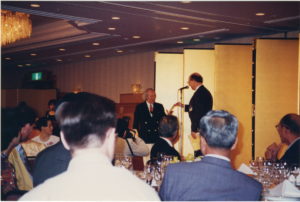
Fundamental to the Hamamatsu conference were the various lectures, workshops and panel discussions. It was our goal to give our Western members the opportunity to discover and learn from our Eastern counterparts. Many conference attendees were conductors, so we invited the world famous orchestral conductor, Tsunanobu Kawamoto, to provide a special session on the famous Saito Conducting System. (Seiji Ozawa is a product of the Saito Conducting System.) For me, it was a wonderful experience to be introduced to an unfamiliar conducting system. Equaling exciting was the opportunity to learn about the Japanese Percussion tradition. This is a very strong, stylized tradition in Japan. The session, taught by Daihachi Oguchi was a whole new world for me. In addition, my friend and colleague, Yasuhide Ito, presented a session on Japanese Music, and Seiji Yokokawa gave a Clarinet Clinic. The late Dr. Richard Strange (Director of Bands at Arizona State University) gave a lecture on the “Tuning of the Wind Band.” Timothy Reynish, Donald Hunsberger, Jan Cober, John Bourgeois and Alan McMurray held several conducting workshops with conductors who were attending the conference. Many of the conference ensembles provided the opportunity for these conductors to conduct a strong musical ensemble and receive instruction and instant feedback on the art of conducting. In addition, there were sessions on the art of rehearsal and numerous presentations of scholarly papers. (Editor’s note: IGEB presented an afternoon of papers as part of the conference.)
Perhaps the most exciting educational component of the conference was when we put all the conference participants on buses and drove to the nearby Yamaha wind instrument factory. I will never forget the large room with hundreds of flutes perched on pegs. It looked like they were growing there. I also remember the gentleman testing one clarinet after another and taking notes on what still needed to be done. Small group tours were also taken to the Kawai Ryuyo Factory where grand pianos were being built.
Many music industry companies from throughout the world provided exhibits in the enormous ACT City exhibition hall.


SAN LUIS OBISPO, CALIFORNIA, USA 1999
At one of the Board meetings during the Hamamatsu Conference, I presented a proposal to have the 1999 WASBE international conference in San Luis Obispo, California. This is the home of California Polytechnic State University where I served as Director of Bands for 44 years. In 1996, the city and the university completed the construction of a world-class concert hall: Harman Hall in The Cohan Performing Arts Center. Administrators were looking for opportunities to book the hall with performances, workshops and lectures. During the Hamamatsu Conference a decision was made by the WASBE Board to have the 9th WASBE International Conference in San Luis Obispo. During the next four years, WASBE and the San Luis Obispo Visitors and Conference Bureau (VCB) worked hard to prepare to host WASBE in 1999. Felix Hauswirth from Switzerland was elected President of WASBE and he appointed Jonni Biaggini, Executive Director of the VCB to serve as the Chairperson of the Local Organizing Committee and me to serve as the Conference Chairman. The Keynote Speaker for this conference was Maestro Frederick Fennell, Principal Conductor of the Tokyo Kosei Wind Orchestra of Japan.
Performing ensembles included the following:
o The California State University Intercollegiate Wind Orchestra, Larry Sutherland and William Johnson, Conductors.
o Indiana State University Faculty Winds, John Boyd, Conductor
o Oklahoma State University Wind Ensemble, Joseph Missal, Conductor
o Sinfonisches Blasorchester, (Bern, Switzerland) Rolf Schumacher, Conductor
o University of Calgary Wind Ensemble, Glenn Price, Conductor
o Fresno State University Alumni Jazz Band, Larry Sutherland, Conductor
o Landesjugend-Blasorchester, (Nordrhein-Westfalen, Germany) Pierre Kuijpers, Conductor
o Amagata Symphonic Band, (Japan) Eichi Tohyama, Conductor
o Korean National University of Arts Wind Ensemble, (Korea) Hyun-Suk Suh, Conductor
o Omnibus Wind Ensemble, (Sweden)
o North Texas State University Wind Ensemble, Eugene Corporon, Conductor
o Marine Band of the Royal Netherlands Navy, (The Netherlands) Maurice Hamers, Conductor
o Long Beach California Municipal Band, Larry Curtis, Conductor
o Stockholm Saxophone Quartet, (Sweden)
o Ensemble Argentino de Clarinets, (Argentina)
o WASBE International Youth Wind Orchestra, Wayne Marshall, Toshiyuki Shimada and Ronald Johnson, Conductors
o The United States Air Force Band, (Washington, D.C.) Col. Lowell Graham, Conductor
The Rehearsal Master Classes included:
o Larry Rachleff and the Indiana State University Faculty Winds
o Wayne Marshall and the WASBE International Youth Wind Orchestra
o Toshiyuki Shimada and the University of Calgary Wind Ensemble
o Craig Kirchhoff and the Sinfonisches Blasorchester of Bern
o Tim Reynish and the North Texas State University Wind Ensemble
The Professional Development Sessions included:
o Chamber Winds: The Core Repertoire with the Omnibus Wind Ensemble: James Croft and Robert Garofalo
o Bodyspeak: Bud Beyer, Northwestern University
o Repertoire Workshop: James Cochran, Joseph Missal and Franco Cesarini
o The Balanced Life – What the Conductor Does is What the Ensemble Gets: Clifford Madsen.
o Motivation – Models in Musical Motivation for the New Millennium: Michael Stecher
o The Quest for Good Music – Combining Personal Taste with Aesthetic Criteria: Craig Kirchhoff
o The Composer’s Laboratory: Lowell Graham


HARMAN HALL,
SAN LUIS OBISPO, CALIFORNIA
SWITZERLAND, SWEDEN, SINGAPORE, IRELAND, USA, TAIWAN, HUNGARY, CZECH REPUBLIC 2001-2011
Between 2001 and 2011, WASBE enjoyed over a decade of significant growth and development. However, as the Internet came into existence, many in the profession saw no need to have international conferences. As a result, attendance at international conferences began to drop off, making it financially difficult to host conferences. The 2013 international conference was canceled due to the lack of a host city. However, an International conference was held in San Jose, California in 2015. Subsequently, the association began to organize regional conferences first in Debrecen, Hungary in 2014 and then in Prague, Czech Republic in 2016. I became president of WASBE for the second time at the end of the San Jose Conference and presided over the regional conference in Prague.
 UTRECHT, THE NETHERLANDS, 2017
UTRECHT, THE NETHERLANDS, 2017
By 2017, it would have been 10 years since WASBE held an international conference in Europe. Being centrally located, Utrecht, The Netherlands was the idea place to have an international conference in Europe. With its medieval old town, canals, a 14th century bell tower and a world class concert hall, Tivoli Vredenburg, Utrecht became the location for the 2017 conference. I was confident the conference would be a huge success. Janneke Hoeberigs and Tamara Visser of Wens Travel – Utrecht became the Chair People of the Local Organizing Committee, and I appointed Past President Bert Aalders to be the conference chairman. I also appointed Past President Felix Hauswirth to be the head of the Artistic Planning Committee. The city of Utrecht donated the Utrecht Conservatorium (Conservatory of Music) and the Tivoli Vredenburg Concert Hall for WASBE’s use during the conference. ZIMIHC, an Utrecht city organization, presented numerous Fringe Festival events during the conference. These included, afternoon church concerts, boat parades, and concerts at Stadhuisbrug, the City Hall.
Performing ensembles included the following:
o American Chamber Winds, David A. Waybright, Conductor.
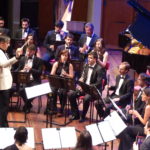
o Koniinklijke Militaire Kapel, “Johan Willem Frisco”,
Tijmen Botma, Conductor.
o Brass-Ensemble des Symphonischen Blasorchesters Schweizer Armeespiel, Major Philippe Monnerat, Conductor.
o Irish Symphonic Wind Orchestra, Liam Daly, Conductor.

o Banda Municipal de Música de Bilbao, José R. Pascual-Vilaplana, Conductor.
o Saratoga High School Symphonic Wind Ensemble, Michael Boitz, Conductor.
o Orchestra Fiati di Valle Camonica, Denis Salvini, Conductor.
o Symphonic Wind Orchestra St. Michael of Thorn, Ivan Meylemans, Conductor.
o Banda Municipal de Barcelona, Salvador Brotons, Conductor.
o Banda Sinfónica Portuguesa, Francisco Ferreira, Conductor.
o Brass Band Schoonhoven, Ivan Meylemans, Conductor.
o Gelders Fanfare Orchestra, Krik van de Kolk, Conductor.
o European Union Youth Wind Orchestra, Jan Cober, Conductor.

WASBE 2017
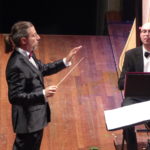

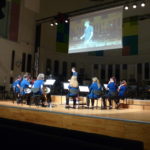
Conducting Masterclasses were taught by Mark Heron, Douglas Bostock, Jan Cober and Dennis Johnson. Alberto Roque headed up the Conductors Panel Discussions, Erwin Nigg headed up a Panel Discussion on Composing for Amateurs. Repertoire sessions were headed up by Dario Sotelo, Miguel Etcheconcelay, Alberto Roque, Felix Hauswirth, Glenn Price and Joop Boerstoel.
Numerous papers were presented including: John Carnahan, “The Referential Tuning System,” Andrea Loss, “Forgotten Band Composers of the 19th & 20th Centuries, Bill Connor, “…of band, kids, grown up kids and communal creativity,” Frederick Speck, “The Search for Musical North,” Andrew Pease, “Repertoire Resources”, Eduard de Boer, “Instrumentation on my music performed at the Conference”, Christopher Dubbins, “Using Score Study as the Foundation for Rehearsal Planning,” “Globalization makes European wind music go through a meat grinder,” and Courtney Snyder, “The Effects of Tension, Balance, and Ictus on Ensemble Sound.”
The Royal Netherlands Music Organization (KNMO) held its meeting in the Conservatory of Music during the conference.
It should be noted that the Music Industry provides a large area of exhibits during each WASBE conference, and Utrecht was no exception!
Gelders Fanfare Orchestra
Utrecht Repertoire:
Conductor: David A. WAYBRIGHT
Soloist: Joseph ALESSI, Trombone
Wolfgang Amadeus Mozart (1756-1791) THE MARRIAGE OF FIGARO OVERTURE
(arr. Bernardini)
Varèse, Edgard (1883-1965) OCTANDRE
Stravinsky, Igor (1882-1971) OCTET FOR WIND INSTRUMENTS
Van Zandt Lane, Peter *1985 CONCERTO FOR TROMBONE AND WINDS
Torke, Michael *1961 OVERNIGHT MAIL
BRASS & PERCUSSION OF THE SWISS ARMY WIND ORCHESTRA
Conductor: Major Philippe MONNERAT
Broughton, Bruce (*1945) FANFARE, MARCHES, HYMNS & FINALE
Saurer, Marcel (*1969) PREMIERE
Hess, Carl (1859-1912) DR HEIMATVOGEL
(arr. Thomas Trachsel)
Traditional DREI SCHWEIZERLIEDER
(arr. Walter Lang-van Os)
IRISH SYMPHONIC WIND ORCHESTRA
Conductor: Liam DALY
Curnow, James (*1943) MUTANZA
O’Carrol, Fergus (*1956) CELTIC PRAYERS
Premiere
Sparke, Philip (*1951) REFLECTIONS ON AN OLD JAPANESE FOLKTUNE
Kelly, Thomas (1917-1985) A WEXFORD RHAPSODY
Giroux, Julie (*1961) LA MEZQUITA DE CORDOBA
BANDA MUNICIPAL DE BILBAO
Conductor: José R. PASCUAL-VILAPLANA
Franco Ribate, José (1978-1951) AGÜERO
Asins Arbó, Miguel (1916-1995) BALLETS
- Ballet e Alfonso XIII
- Ballet de l’Animalot
- Ballet del Pardalero
- Ballet del Sereno
De Meij, Johan (*1953) FIFTY SHADES OF E
Blanquer Ponsoda, Amando CALEIDOSCOPIO
(1935-2005)
Guridi, Jesús (1886-1961) UNA AVENTURA DE DON QUIJOTE
(arr. J. Franco / adp. Pascual-Vilaplana)
Fayos Jordán, José Miguel (*1981) TRIBAL ELEMENTS
ORCHESTRA DI FIATI DI VALLECAMONICA
Conductor: Denis SALVINI
Guest Conductor: Douglas BOSTOCK
Soloist: Devid CESTE, Euphonium
Manente, Guiseppe (1867-1941) PICCOLI EROI
(arr. Salvatore Farina)
Giacometti, Antonio (*1957) KINDARA OVERTURE
Premiere
Mashima, Toshio (1949-2016) LES TROIS NOTES DU JAPON
De Meij, Johan (*1953) UFO CONCERTO,
for solo euphonium and wind orchestra
ST MICHAEL OF THORN
Conductor: Ivan MEYLEMANS
Soloists: Jörgen VAN RIJEN, Trombone
Alexander VERBEEK, Trombone
van Delft, Marc (*1958) DANCE SUITE
Part 1: Dance
Part 2: Intermezzo
Part 3: Finale
Premiere
De Meij, Johan (*1953) TWO BONE CONCERTO
Schmitt, Florent (1870-1958) DIONYSIAQUES, op. 62
Rimsky-Korsakov, Nicolai CAPRICCIO
BARCELONA SYMPHONIC BAND (BANDA MUNICIPAL DE BARCELONA)
Conductor: Salvador BROTONS
Lamote de Grignon, Joan (1872-1949) SCHERZO SOBRE UN TEMA POPULAR CATALÀ
(version for Symphonic band 1915) (SCHERZO ABOUT A POPULAR CATALAN THEME)
Toldrà, Eduard (1895-1962) EMPÚRIES, SARDANA LLIURE
(transcribed by Joan Lamote de Grignon)
Serra, Joaquim (1907-1957) PUIGSOLIU, SYMPHONIC POEM
(transcribed by Joan Alfonso)
Oltra, Manuel (1922-2015) MONTMAGASTRE, A LITTLE SYMPHONIC SCENE
(transcribed byJordi León)
Borgunyó, Agustí (1894-1967) L’APLEC. PEASANT CELEBRATION
(transcribed byJoan Lluís Moraleda)
Montsalvatge, Xavier (1912-2002) MUSIC FOR A SUNDAY
- Fanfare
- The Llofriu chotis (traditional spanish dance)
- The Poble Sec polka
Brotons, Salvador (*1959) SYMPHONY NO.6 CONCISE, OP.122
- Frontal
- Procession
- Scherzo
- Passacaglia
- Finale
BANDA SINFÓNICA PORTUGUESA
Conductor: Francisco FERREIRA
Soloist: Henk van Twillert, Baritone Saxophone and Electronic
Carvalho, Luís (*1974) CHIAROSCURO
Três esquissos para Banda Sinfónica
Meijering, Chiel (*1954) TRANSMUTES FOR SYMPHONIC WIND BAND,
BARITONE SAXOPHONE AND ELECTRONIC
de Jesus, Nelson (*1986) PORTO DE SAUDADES
- Fado Menor do Porto
- Moda do Entrudo
- Valsa Antiga
- Cava Vinha Malhão
- Palácio de Cristal
- Clérigos
- Vinho do Porto
- Fado Menor (reprise)
- Finale
Waespi, Oliver (*1971) OUT OF EARTH
- Largo – Agitato
- Adagio
- Energico
BRASS BAND SCHOONHOVEN
Conductor: Ivan MEYLEMANS
Soloist: Robbert Vos, Euphonium
Lovatt-Cooper, Paul (*1976) WHERE EAGLES SING
Overhead, Christian (*1989) UNDERGROUND CONCERTO FOR EUPHONIUM,
PERCUSSION AND BRASS BAND
Bond, Christopher (*1992) ARISTOTLE’S AIR
de Boer, Eduard (*1957) SCHUMANN RESONANCES
Premiere
GELDERS FANFARE ORKEST
Conductor: Erik VAN DE KOLK
Nieuwenhuis, Stan (*1966) FALSE FRONT
Premiere
Scott, Andy (*1989) A CHILD LIKE YOU
Janssen, Harrie (*1960) PREMIERE
Pütz, Marco (*1958) TIME FOR OUTRAGE
THE FUTURE OF WASBE
WASBE is now 37 years old. It remains the only international association of wind band people in the world. When it began, we had typewriters, telephones, mail and jet airplanes. What we did not have in 1981 was computers, Internet and fax machines. Still we managed to put together an organization that, in 37 years, has changed the wind band world. With modern technology, we can now communicate in a way that was impossible in 1981. The Internet and its many devices has given us incredible ways of sharing ideas and has made it much easier to realize our mission, which is:
- To promote symphonic bands and wind ensembles as serious and distinctive mediums of musical expression and cultural heritage.
- To assist in all ways possible the development of band activities throughout the world.
- To encourage the international exchange of conductors, teachers, students, and composers.
- To help others recognize the importance of the symphonic wind band and the wind ensemble for international and national communication and understanding.
- To encourage the composition of band literature of excellence that reflects national heritages and transcends international boundaries.
William V. Johnson
William V. Johnson
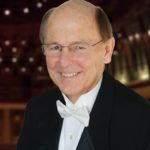
William V. Johnson, Professor of Music Emeritus at California Polytechnic State University, San Luis Obispo, California, served as the university’s Director of Bands from 1966 to 2010, a 44 year tenure. He served as the Artistic Director of the San Luis Obispo Wind Orchestra from 2000 to 2014.
Johnson is the Immediate Past President of the World Association for Symphonic Bands and Ensembles (WASBE). WASBE has a membership of over 1,000 individuals and organizations in more than 50 countries. The association is dedicated to the enhancement of the symphonic band and wind ensemble as serious and distinctive medium of musical expression and cultural heritage. http://www.wasbe.org/
Johnson also serves as the President of Opera San Luis Obispo (California).
As a guest conductor, lecturer and clinician, Johnson has conducted wind ensembles and orchestras in the United States, Canada, Japan, Germany, France, The Netherlands, Czech Republic, Great Britain, Switzerland, Austria, New Zealand, Australia, Hong Kong, Israel, Korea, Singapore, China, Hungary and Ireland.
Johnson was elected into the American Bandmasters Association (ABA) in 1984 and served as host for the 73rd and 82nd ABA conventions held in San Luis Obispo in 2007 and 2016.
Johnson is an arranger, transcriber and composer of music for the wind band as well as wind chamber ensembles. His works can be found at https://wvjohnson.com/
In 1962, he received his Bachelor’s Degree in music from the Indiana University School of Music and his graduate degree in Music from The University of Michigan School of Music.
He was selected as one of three Distinguished Teachers at Cal Poly. Recently, he was presented the Lifetime Achievement Award by the California Band Directors Association and received the Distinguished Service to Music Medal from Kappa Kappa Psi.
